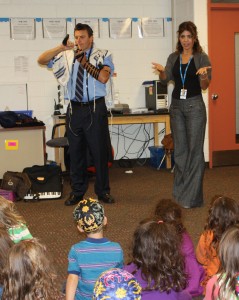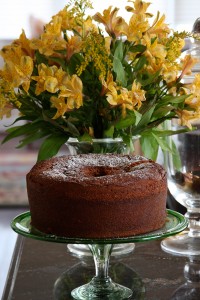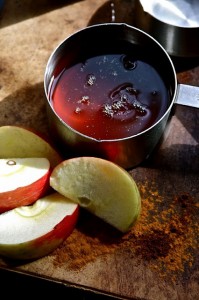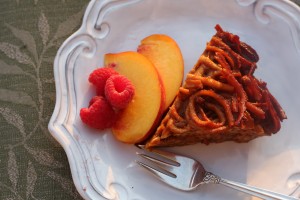May it be a good year. May it be a sweet new year. May you be inscribed in the Book of Life.
These are the traditional blessings of Rosh Hashanah, the Jewish New Year 5773 which begins at sundown on Sunday, September 16.

In the scriptures it is written: for every festival a feast. And so it is written: in Jewish kitchens everywhere in the weeks to come, cooks will open their books to recount and muster the mysteries and delicacies of brisket of beef, kichel, tayglach, challah, kugels of all kind, and yes, the ever-present, prerequisite: honey cake.
Symbolizing hope and nourishment for a sweet new year, honey cake does not always rise to the list of holiday favorites.
“Too dry,” some complain.
“Too sweet,” others think.
Not a fan? Reconsider your recipe.
According to The Book of Jewish Food by Claudia Roden, honey cake – laden with spices, almonds and ginger – has been a celebratory Jewish cake since the early Middle Ages in Germany. Who knew? The earliest recorded recipe for a festive “Lebkuchen” (a honey-sweetened gingerbread) dates back to the 16th Century. Earlier mentions in Jewish records trace the recipe as far back as the 12th Century, when it was the custom of young boys to bring honey cake on the first day of school.
A Honey of a Recipe

You can thank Marcy Goldman of Better Baking.com for this most definitely delicious “Moist and Majestic Honey Cake.” Like most honey cakes, this one keeps well and can be made a couple of days ahead. The original version of this cake is in the 10th Anniversary Edition of A Treasury of Jewish Holiday Baking (Whitecap Books, 2009). It is exceptional, sweet and spicy – sure to make a honey cake hater into a honey cake lover. You can’t do better.
This cake is best baked in a nine-inch angel food cake pan, but you can also make it in one 9 or 10-inch tube or Bundt cake pan, a 9×13-inch sheet cake pan, or two 5-inch loaf pans. And yes, it’s pareve.
- 3 3/4 cups all-purpose flour
- 4 tsp. baking powder
- 3/4 tsp. baking soda
- 1/2 tsp. salt
- 4 tsp. ground cinnamon
- 1/2 tsp. ground cloves
- 1/2 tsp. ground allspice
- 1 cup vegetable oil
- 1 cup honey
- 1 1/2 cups granulated sugar
- 1/2 cup brown sugar
- 4 eggs
- 1 tsp. vanilla
- 1 cup warm coffee, strong tea or Coca-Cola
- 1/2 cup fresh orange juice
- 1/4 cup rye or whiskey (or substitute orange juice or coffee)
- 1/2 cup slivered almonds
Preheat the oven to 350 degrees. Lightly grease pan(s). For tube and angel food pans, line the bottom with lightly greased parchment paper, cut to fit. Have ready doubled up baking sheets with a piece of parchment on top.
In a large bowl, whisk together the flour, baking powder, baking soda, salt, cinnamon, cloves and allspice. Make a well in the center. Add oil, honey, white sugar, brown sugar, eggs, vanilla, coffee, tea or cola, orange juice and rye or whiskey.
Using a strong wire whisk or in an electric mixer on slow speed, stir together well to make a thick, well-blended batter, making sure that no ingredients are stuck to the bottom.
Spoon batter into prepared pan(s). Sprinkle top of cake(s) evenly with almonds. Place cake pan(s) on two baking sheets stacked together. (This will ensure that cakes bake properly.)
Bake until cake springs back when you gently touch the cake center. For angel and tube cake pans, 60-80 minutes; loaf pans, about 45-55 minutes. For sheet-style cakes, baking time is 40-45 minutes. Let cake stand 20 minutes before removing from pan.
More Federation family favorites for feasting and breaking the fast

What do we talk about when we talk about Jewish holiday food? We took a quick survey of our staffers, and here’s what collectively we would put on the table to break the Yom Kippur fast: lox, cream cheese and bagels, blintze soufflé, tuna salad, challah and cheese soufflé, French onion soup Jewish-style, sweet noodle kugel (our mothers’ recipe), Jerusalem noodle kugel, pull-apart cake and honey cupcakes. For good measure, we’ve included a few of our favorite recipes. Enjoy.
Milgrom Family “Pull-Apart” cake
From Marianne Milgrom-Bloomberg, Senior Campaign Associate: Okay, this isn’t honey cake, but it comes our way from Marianne who claims it as Milgrom family tradition. You might like to serve it at Break Fast. The Milgroms like to scope out their favorite pieces – an outside crusty piece, or maybe an inside gooey piece – everyone looks forward to the cake and enjoys it as a treat for breaking the fast.
- 1 cup milk
- 1/2 cup plus 1/2 tsp sugar divided
- 1/2 cup butter
- 1 pkg. active dry yeast
- 1/4 cup warm water
- 2 large eggs, beaten
- 2 tsp. vanilla
- 1 tsp. salt
- 4- 4 1/2 cups flour
- 1/2 cup sweet butter
- 1 cup sugar
- 1 tsp. cinnamon
In a medium saucepan, scald milk; pour into large mixing bowl, add 1/2 cup sugar and 1/2 cup butter. Stir until melted and dissolved. Cool to lukewarm.
Meanwhile in a small bowl or cup, dissolve yeast with remaining 1/2 teaspoon sugar in warm water.
When milk mixture is lukewarm, stir in beaten eggs, vanilla, salt and yeast mixture.
Gradually add flour, beating after each addition, finally beating until smooth.
The dough will be soft and sticky. Turn dough into large well-greased bowl, cover with a dishtowel and let rise, about 1 hour.
Punch down dough and let rise again until doubled in bulk – another hour.
In a small saucepan, melt sweet butter, cool. In a medium bowl, combine sugar and cinnamon, mix well.
Pinch off pieces of dough about the size of large walnuts.
Dip pieces in butter and roll in sugar cinnamon mixture.
Layer pieces in a well-greased 10-inch tube pan and let rise about 45 minutes.
Bake at 350 for 35 minutes or until puffed and brown on top.
Cool in pan before inverting on serving platter.
Egg and Cheese Challah Soufflè
From Megan Topper: Here’s a really easy recipe that I time to have ready right after the fast…it’s light but filling and smells so good.
- 6 eggs
- 2 cups of milk
- 12 slices Challah, with crusts removed
- dash of salt and pepper
- 1/2 lb. cheddar cheese grated
- garlic powder
- Next day: 1/2 cup melted margarine
Layer 1/2 the bread in a 9 X 13 baking pan. Sprinkle with half of the cheese. Repeat layering process. Beat eggs and milk together. To this, add salt, pepper and garlic powder. Mix well. Pour over the soufflé. Cover and refrigerate over night. Remove the soufflé from the refrigerator one half hour before baking. Pour the melted margarine over it. Bake at 350 degrees for an hour.
Jerusalem Noodle Kugel

From Vwriter: myJewishDetroit editor: A variation on the familiar sweet noodle puddings, here’s a savory and spicy kugel, made with thin spaghetti-style noodles, caramelized in brown sugar and oil and seasoned with black pepper. This simple recipe was brought to the city of Jerusalem by Eastern European Hasidic Jews in the 18th Century and traditionally is eaten after Shabbat morning services.
The kugel’s other distinguishing feature is that it is baked in a very low oven for many hours, making it an ideal choice for a meal prepared before the Sabbath or to break the fast on Yom Kippur. The recipe will also get dark-sugar-brown and crispy-crusted with a moist interior when baked at 350 degrees for one hour.
- 1/4 cup vegetable oil (corn, canola, peanut, etc.), plus 1 tablespoon
- 1/2 cup sugar
- 1 pound fine egg noodles
- 6 eggs
- 2 teaspoons freshly ground black pepper
- 2 tablespoons salt
- 1/3 cup raisins (optional)
To cook the noodles, bring about 4 quarts of water to a rolling boil.
Meanwhile, in a small saucepan, over low heat, stir the oil into the sugar. Watch carefully, stirring or swirling the pan occasionally, until the sugar becomes a nutty brown. The oil will separate from the caramel. Remove from heat immediately.
Also while the water for the noodles comes to the boil, in a large bowl, beat the eggs with the pepper.
When the water is boiling, add the 2 tablespoons of salt, then stir in the noodles. Boil the noodles for 5 minutes.
While the noodles are cooking, grease a 9 by 13-inch baking pan and preheat the oven to 350 degrees. Also place the already browned sugar on medium heat and melt it until very runny.
When the noodles are done, drain immediately, then turn them back into the pot they cooked in. Toss with the additional 1 tablespoon of oil, so they won’t stick together.
Stir the caramel, making sure it is runny, and let it cook a few seconds longer until it becomes a darker brown. Quickly turn the caramel and oil in the pan into the noodles, stirring them in while pouring. Add the beaten eggs and stir well again. Add the raisins, if desired.
Pour into the prepared baking pan, even out the top with a spatula, and bake for 1 hour in the preheated oven.
To serve, run a sharp knife around the edges of the kugel, then cut into squares. Carefully remove from the pan using a metal spatula, running the spatula under any sticky parts before trying to lift the pieces out.
What do you talk about when you talk about Jewish holiday food? Please share. Tweet @myJDetroit or Friend us.




